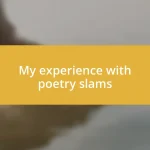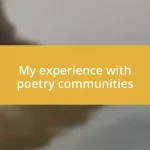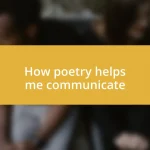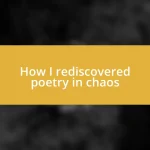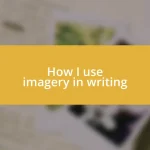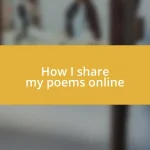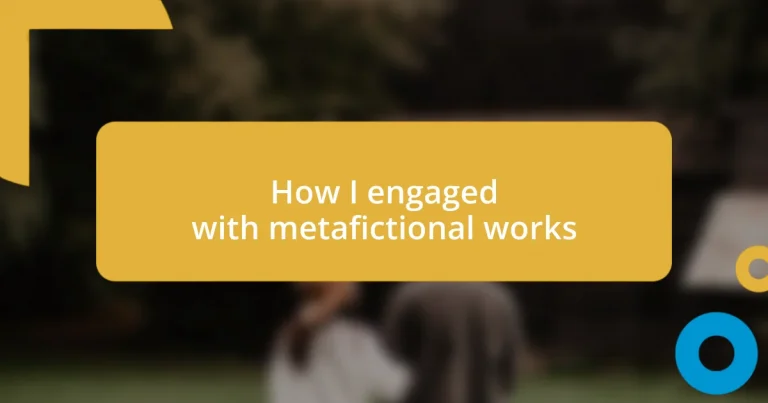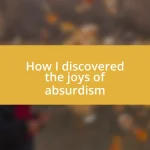Key takeaways:
- Metafiction challenges traditional storytelling by encouraging active reader engagement and self-reflection on the nature of fiction.
- Techniques for engaging with metafiction include analyzing narrative structure, taking notes, and participating in discussions to enhance understanding.
- Metafiction creates connections to real life, prompting introspection about personal experiences, choices, and the interplay between fiction and reality.
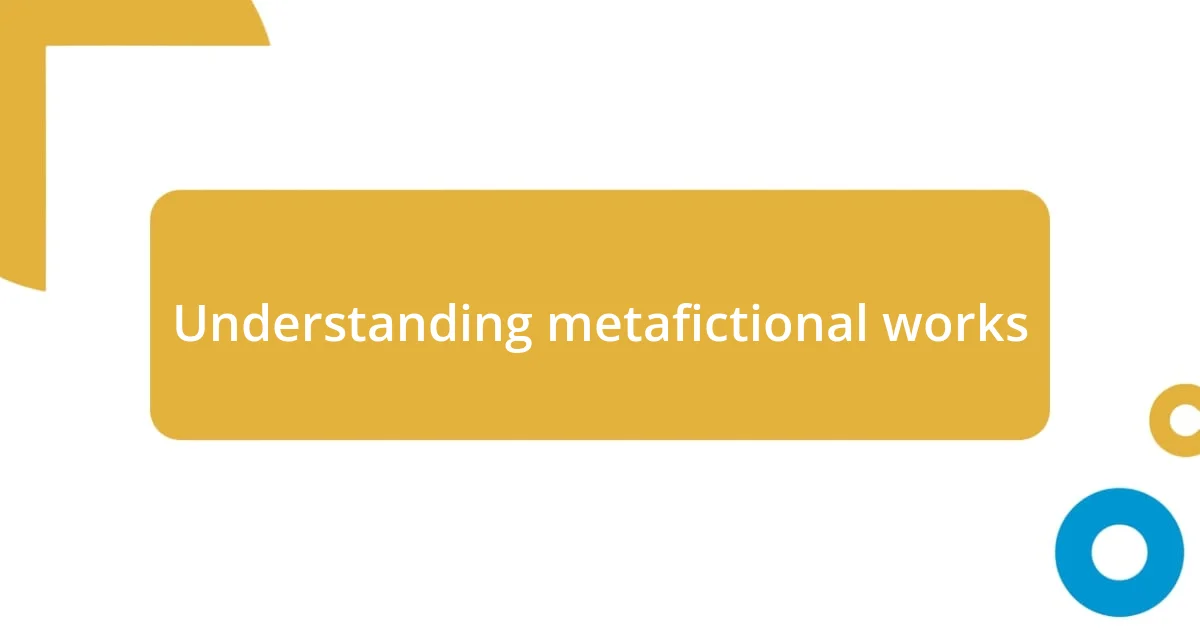
Understanding metafictional works
Metafictional works always intrigue me because they challenge the traditional boundaries of storytelling. I often find myself asking, “What does it mean for a story to acknowledge its own creation?” This self-awareness in narrative can spark a deep reflection on the nature of fiction itself, making me feel like I’m not just a passive reader but an active participant in the unfolding narrative.
One of my first encounters with metafiction was while reading Jorge Luis Borges’s “The Garden of Forking Paths.” I was completely captivated by how he blurred the lines between fiction and reality. Borges’ work made me realize that stories can exist in multiple dimensions, forcing me to contemplate the choices characters make and, by extension, my own reading choices. It’s a mind-bending experience that invites a personal connection to the text.
Then there’s the delightful confusion of works like “If on a winter’s night a traveler” by Italo Calvino. I remember feeling both exhilarated and puzzled as I navigated the shifting perspectives. Each chapter drew me into a new story, only for the narrative to playfully remind me that I was reading—not quite fitting into a preconceived genre or structure. That’s the magic of metafiction; it invites us to ponder the mechanics of storytelling and encourages us to look beyond the pages.
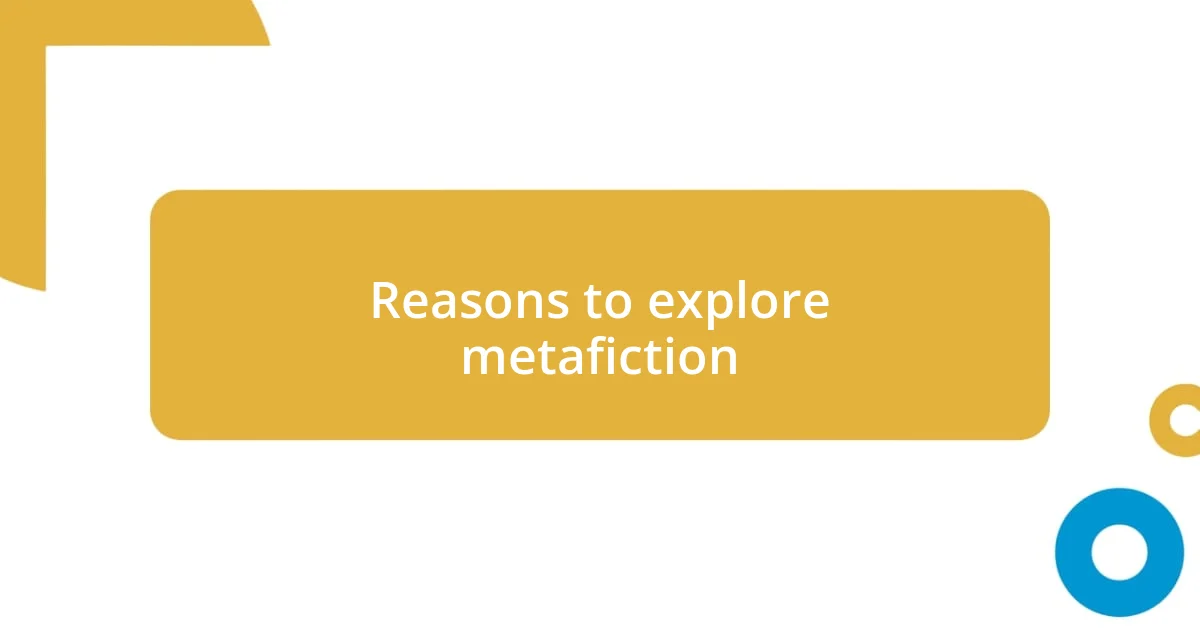
Reasons to explore metafiction
Exploring metafiction offers a unique adventure that challenges my perceptions as a reader. There’s something exhilarating about encountering stories that remind me I’m immersed in a crafted world, prompting me to question not just the narrative, but the very essence of storytelling. I remember the first time I encountered works like “House of Leaves” by Mark Z. Danielewski; the shifting formats on the page made me physically adjust how I read. It was like the story was engaging in a dance with me, pulling me in and demanding my full attention.
Here are some compelling reasons to explore metafiction:
- Self-Reflection: Metafiction pushes me to engage with my individual reading experiences and biases.
- Creative Innovation: It often showcases unique narrative structures that spark my imagination.
- Interactive Reading: I feel more like a co-creator in the storytelling process, enhancing my emotional involvement.
- Philosophical Inquiry: These works prompt deep questions about the nature of reality and fiction’s role within it.
- Break from Tradition: I appreciate how metafiction breaks conventional storytelling rules, offering a refreshing perspective.
Diving into these layered narratives has taught me to value that interplay between reader and author, helping me to develop a deeper appreciation for the art of writing itself.
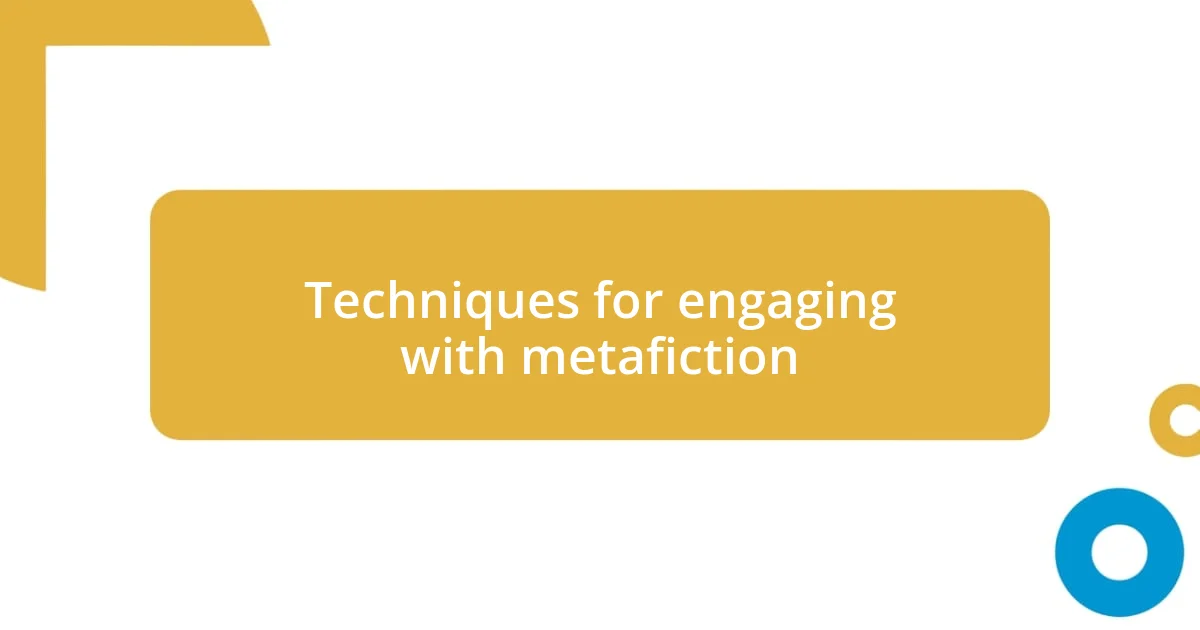
Techniques for engaging with metafiction
Engaging with metafiction requires a keen sense of awareness about the narrative’s self-referential qualities. When I approach these works, I often make it a point to pause and reflect on the author’s intentions. For instance, I remember reading “The Unfortunates” by B.S. Johnson, where the unconventional structure of loose pages forced me to consider the physicality of the book itself. It was a thrilling reminder that I’m experiencing not just a story, but a crafted form that invites my critical engagement.
Another technique I find enriching is the practice of taking notes as I read. This allows me to capture my immediate reactions, questions, and thoughts, enhancing my interaction with the text. During my reading of “Shooting an Elephant” by George Orwell, jotting down my thoughts about narrative reliability and the author’s biases led me to deepen my understanding of various layers in the story. It transformed my passive reading into an active investigation, which made the experience much more immersive and fulfilling.
Lastly, I enjoy discussing metafictional works with fellow readers. Each conversation opens up new perspectives and insights that I might not have considered on my own. I clearly recall some insightful debates over “The French Lieutenant’s Woman” by John Fowles, where the author’s direct address to the reader sparked rich debates throughout our book club. This exchange of ideas illuminated facets of the stories that enhanced my overall appreciation for metafiction’s complexity.
| Technique | Description |
|---|---|
| Self-Reflection | Consider the author’s intentions and how the narrative structure impacts your experience. |
| Note-taking | Write down thoughts and questions as you read to deepen your engagement with the text. |
| Discussion | Engage in conversations with others to explore diverse perspectives and insights. |
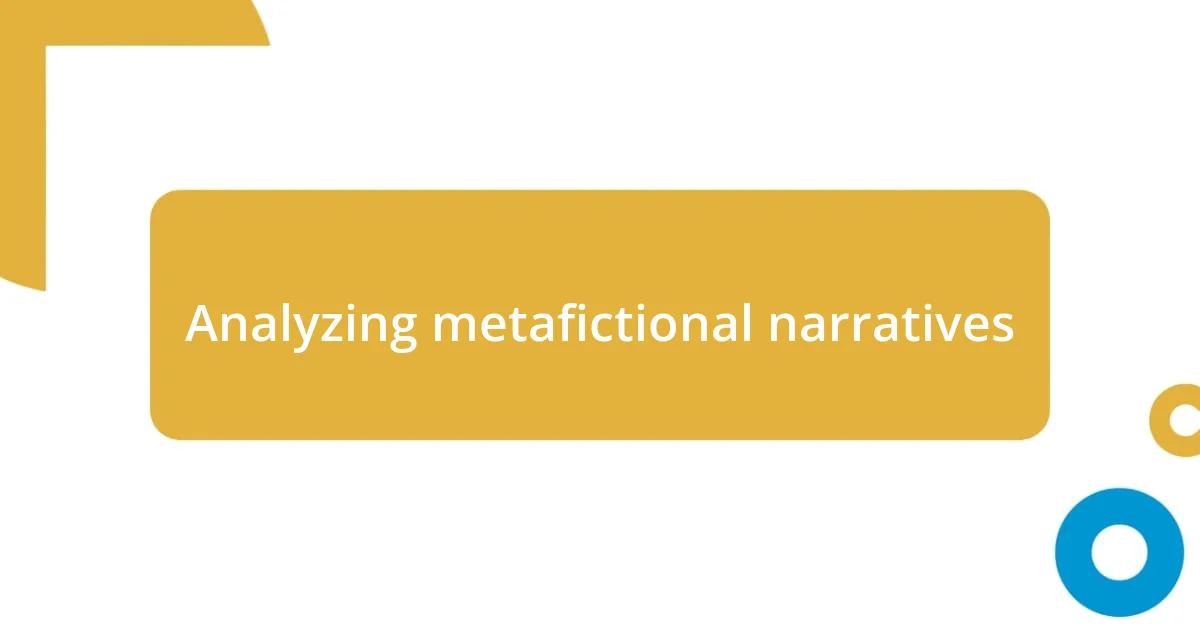
Analyzing metafictional narratives
Metafictional narratives invite a deeper analysis of storytelling’s mechanics. As I navigated through “If on a winter’s night a traveler” by Italo Calvino, I found myself reflecting on how the author’s playful manipulation of narrative structure keeps readers on their toes. Isn’t it fascinating how these layers of complexity can evoke a sense of wonder and confusion simultaneously?
When I consider the way metafiction examines the boundaries of fiction, I recall my experience with “The Metamorphosis” by Franz Kafka. The story’s bizarre premise forces readers to grapple with their understanding of identity and reality; it truly challenges my perception of what it means to be human. Engaging with texts like this isn’t just about plot; it becomes an exploration of existential themes that resonate on a personal level.
Delving into metafiction also prompts me to question the very nature of authorship. I remember reading “Atonement” by Ian McEwan and feeling an unsettling tug at the notion of control within storytelling. It left me pondering—can authors shape destinies, or do characters ultimately forge their own paths? This ambiguity not only heightens the narrative’s impact but encourages me to consider my own role as a reader in this intricate dance of creativity.
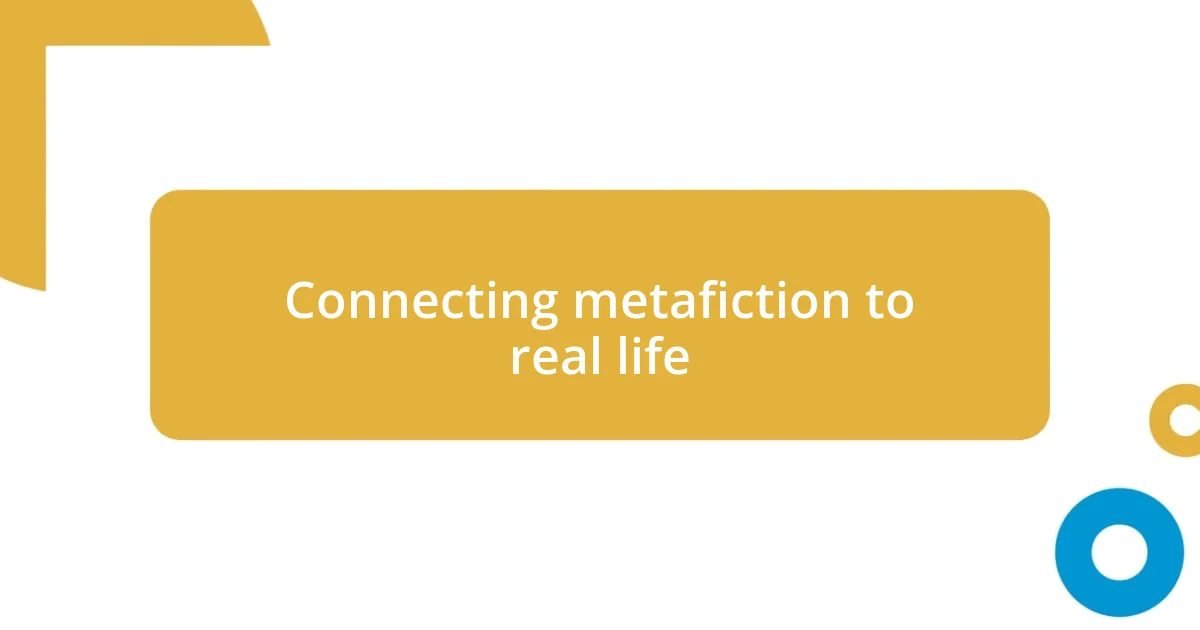
Connecting metafiction to real life
The connection between metafiction and real life often feels like peering into a mirror. I remember a moment in my life when I was deeply moved by “Slaughterhouse-Five” by Kurt Vonnegut. As the protagonist navigates time and trauma, it struck me that our own lives can be just as fragmented. How often do we spiral through memories, experiencing moments out of sequence? This realization made me appreciate the irony in Vonnegut’s narrative choices, reflecting my own struggles with time and the chaotic nature of existence.
I find that metafiction can even challenge my perceptions of truth. Reflecting on “The French Lieutenant’s Woman” again, I was captivated by how Fowles invites the reader to ponder the nature of choice and consequence. It made me think about decisions I’ve faced in my life—those moments where the outcome felt predetermined versus those where I believed I held agency. Isn’t it intriguing how literature can echo our own dilemmas? This interplay between fiction and reality invites introspection, allowing me to explore the complexities of my own experiences.
The emotional resonance of metafiction is undeniable. Sometimes, when I read works like “Naked Lunch” by William S. Burroughs, I grapple with the chaotic, raw portrayal of life that feels both disturbing and honest. How do we reconcile the messiness of existence with the desire for coherence? This connection urges me to confront uncomfortable truths about myself and society. Engaging with art that mirrors our complexities not only deepens my understanding of the narratives themselves but also enriches my awareness of my own humanity.
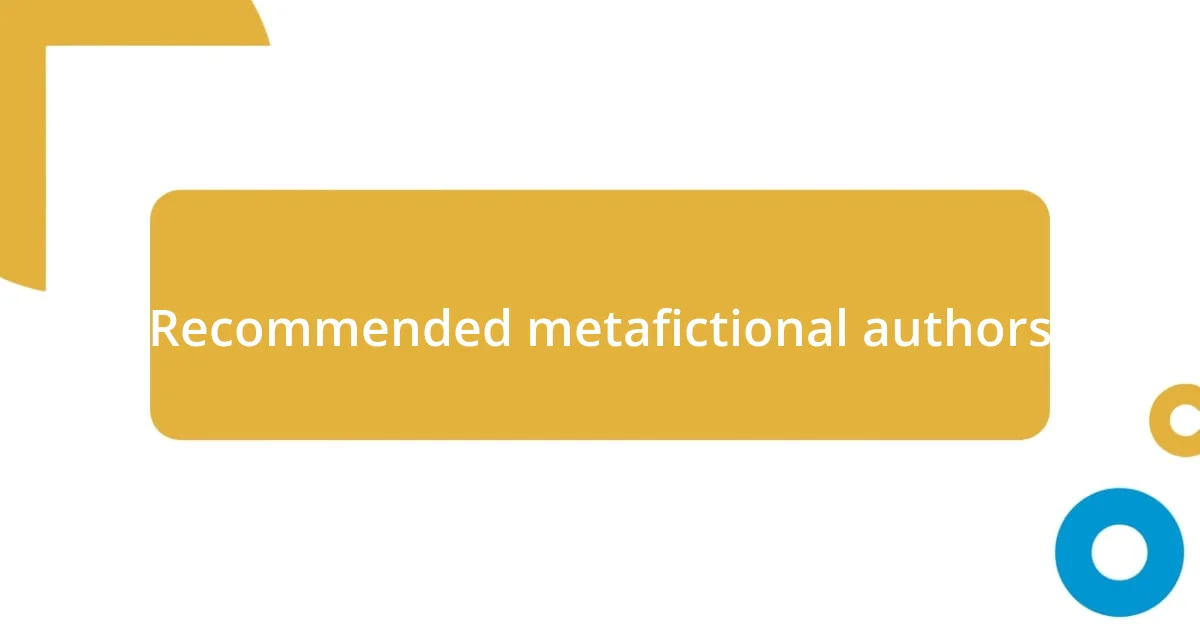
Recommended metafictional authors
One author I enthusiastically recommend is Jorge Luis Borges. His short stories, especially in “Ficciones,” often blur the lines between reality and fiction, making me question the very fabric of existence. I can vividly recall reading “The Lottery in Babilonia” and feeling as though my understanding of chance and fate was turned upside down. Isn’t it intriguing how Borges not only constructs narratives but also plays with the infinite possibilities of narrative itself?
Another brilliant metafictional voice is Paul Auster, particularly in “The New York Trilogy.” I was drawn in by his ability to weave together mystery and existentialism, creating a narrative that feels as much about the act of storytelling as it is about the characters. One moment that really resonated with me was when I realized the detective was not just solving a case but also navigating the elusive nature of identity. How often do we seek to define ourselves through the stories we tell? Auster’s work beautifully encapsulates that struggle.
Lastly, I cannot overlook the genius of David Foster Wallace. In “Infinite Jest,” he crafts a narrative that reflects our contemporary anxieties, making me question the very nature of entertainment and addiction. I still remember the overwhelming sensation I experienced as I traversed his complex footnotes—did I truly grasp the story, or was I merely skimming the surface? Wallace’s bold approach encourages readers to embrace the complexity of thought, pushing us to delve deeper into both the narrative and our own lives. How often do we pause to reflect on the stories we engage with?
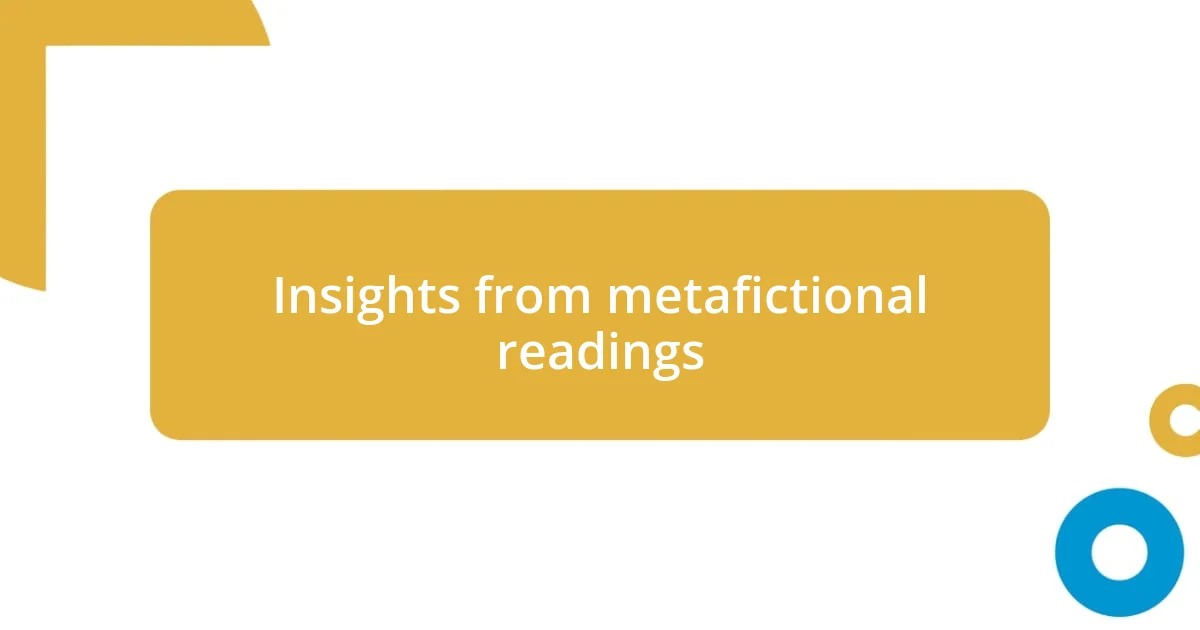
Insights from metafictional readings
Metafictional readings provide a unique lens through which we can explore our own vulnerabilities. I remember flipping through “If on a winter’s night a traveler” by Italo Calvino, feeling increasingly aware of how my own story intersects with the multiple narratives within the text. It’s almost like the book wasn’t just presenting a story but inviting me to consider my role as a reader and how my interpretation shapes the experience. Have you ever felt like the boundaries between reader and story blurred, allowing for a deeper connection?
When diving into metafiction, I often uncover insights about the constructs of narrative itself. Reading “The Unbearable Lightness of Being” by Milan Kundera, I was struck by the idea of eternal return. This philosophical questioning led me to reflect on my own life choices and the notion of lightness versus weight. Are our decisions as monumental as we believe, or are they mere whims in the grand tapestry of fate? These existential ponderings continue to challenge my perception and offer a richer understanding of self.
The emotional depth in metafiction allows me to confront my own truths in ways I hadn’t anticipated. I recall reading “House of Leaves” by Mark Z. Danielewski, where the disarray of the narrative mirrored my inner chaos during a turbulent time in my life. The text’s fragmented form pushed me to question how I navigate my own disjointed experiences. How do we make sense of our lives when everything feels so unpredictable? Engaging with this kind of literature not only provides solace but also encourages a profound dialogue with oneself.




